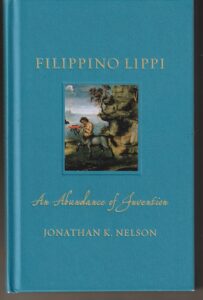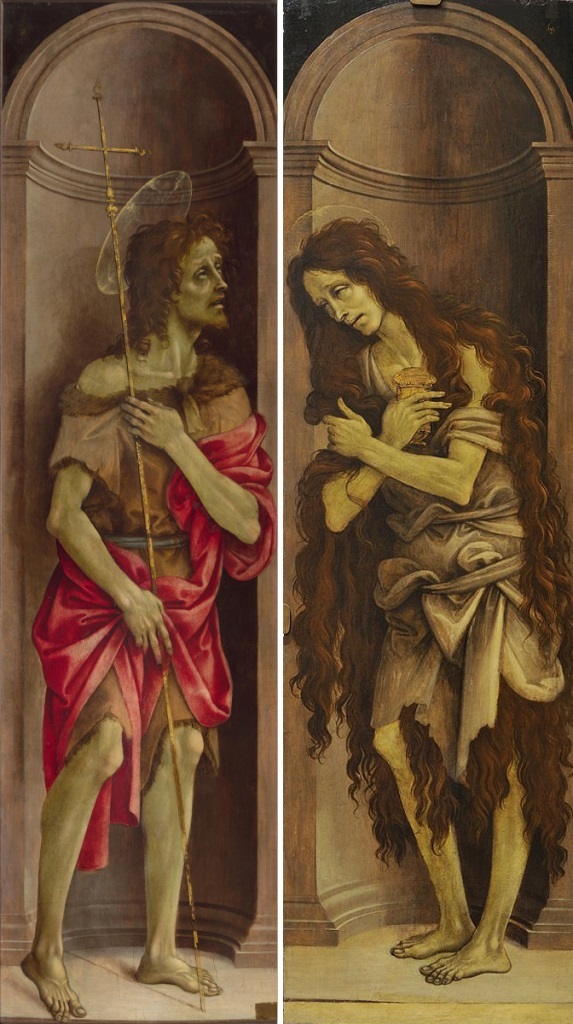Florence at the end of the fifteenth century could be a dangerous place to have religious opinions.
Girolamo Savonarola, an ascetic Dominican friar, won great praise and power by preaching against the inordinate accumulation of wealth and its expression in artistic and social excesses. Indeed, putting his words into action, he held a regular “bonfire of the vanities” in which anything he considered objectionable was burned — paintings, sculptures, tapestries, manuscripts, books, mirrors and even musical instruments.
By 1494, Savonarola was the de facto ruler of the city, strong enough to defy Pope Alexander VI and continue preaching despite a papal ban.
But, then,….well, then, the friar was excommunicated in 1497, and public opinion in Florence turned against him. And, then, he and two of his confidants were arrested, tortured and hanged.

It was in such a fraught climate that Filippino Lippi (1457-1504), son of one great Renaissance artist and student of another — and a great artist himself — not just survived but thrived, as Jonathan K. Nelson demonstrates in his 2022 book Filippino Lippi: An Abundance of Invention.
Florid and grave works of art
Lippi thrived even though, during that tense decade at the end of the 1400s, he was creating the sorts of flashy paintings that were rich in imagery and allusion — and were hated by Savonarola and his followers.
At the same time, however, he was painting more somber and direct works in the scaled-back, no-distraction style that the friar favored. Nelson writes:
An awareness of the rules of art allowed Filippino in his last years to create both florid paintings, filled with details that pleased the eye, and grave works designed to stir the emotions of visitors….
Filippino had the sensitivity to understand these diverse needs and the pictorial intelligence to express them with highly original solutions.
“The nature of holy vision”
Filippino Lippi’s first art teacher was his father Fra Filippo Lippi, a scandalous Carmelite monk who “kidnapped” the woman who became the boy’s mother, a Dominican nun who was, it seems, already his lover.
An earlier student of the elder Lippi was Sandro Botticelli who, in his turn, took his teacher’s son into his own workshop as an apprentice.
Filippino was still in his twenties when he painted one of his masterpieces Vision of St. Bernard, a large and complex painting that was inspired by a passage about the saint in Dante’s Paradiso:

In Paradiso XXXI, Bernard directs Dante to contemplate the heavens, and the canto closes with an intricate description of the impact of inspired looking. The fiery intensity of Dante’s gaze leads Bernard to look at the Virgin with great affection.
Likewise, the painted representation of Bernard’s vision was designed to inspire the devotion of all who saw it. Filippino’s genius was to transform Dante’s intricate sequence of intense looking into an image that explores the nature of holy vision and religious contemplation.
“So much artifice”
The inventiveness and dexterity that Lippi showed in Vision is a theme through much of his later art, such as in the fresco cycle in the Strozzi Chapel, completed in 1502. Nelson writes that the visual cleverness on exhibit in the chapel shows not only “Filippino’s delight in the bizarre and interest in surprising the viewer, but the value of art in the service of religion,” most apparent in the window wall.
A bizarre architectural fantasy visually extends the stone tomb upward so that it encompasses the entire wall. Modern observers, if they view the frescoes in natural light, often assume that the projecting columns are made of marble until they spot the colorful angels perched on the entablature….The window wall meets Leonardo da Vinci’s criteria for successful painting: it appears “detached from the wall…and deceives subtle judges.”

However, this is exactly the sort of complexity that Savonarola condemned in sermons, music and art.
From his Florentine pulpit in 1949 the Dominican friar lamented, “nowadays they make images in churches with so much artifice…that one does not consider God, but only the artifice of the figures.”
For Savonarola, this represented the epitome of “exterior” forms of worship, which included ornate priestly vestments, erudite discourse and extravagant church decorations.
“No ‘superfluousness’’”
Other works by Lippi were more in keeping with the preacher’s call for a serious and straight-forward depiction of religious subjects.
One example is his austere Crucifixion with Virgin and St. Francis, executed from 1498-1500, a triptych with a reverent image of Christ on the cross, between the wings featuring haggard images of Sts. John the Baptist and Mary Magdelene.

Both the style and iconography of this altarpiece have direct correspondence with beliefs expressed by Savonarola….In this central panel, destroyed in the Second World War but known from photographs, Christ appears with his eyes closed and past suffering, flanked by the kneeling Virgin and St. Francis….
The work contains no “superfluousness,” the term that Savonarola used repeatedly to condemn unnecessary actions and luxuries in all aspects of life.
Nelson’s book stresses the “abundance of invention” in Lippi’s work.
But, beyond the paintings themselves, there was high invention in the tightrope-walk that Lippi did in serving patrons from both sides of the theological divide.
Patrick T. Reardon
3.19.24
Written by : Patrick T. Reardon
For more than three decades Patrick T. Reardon was an urban affairs writer, a feature writer, a columnist, and an editor for the Chicago Tribune. In 2000 he was one of a team of 50 staff members who won a Pulitzer Prize for explanatory reporting. Now a freelance writer and poet, he has contributed chapters to several books and is the author of Faith Stripped to Its Essence. His website is https://patricktreardon.com/.
